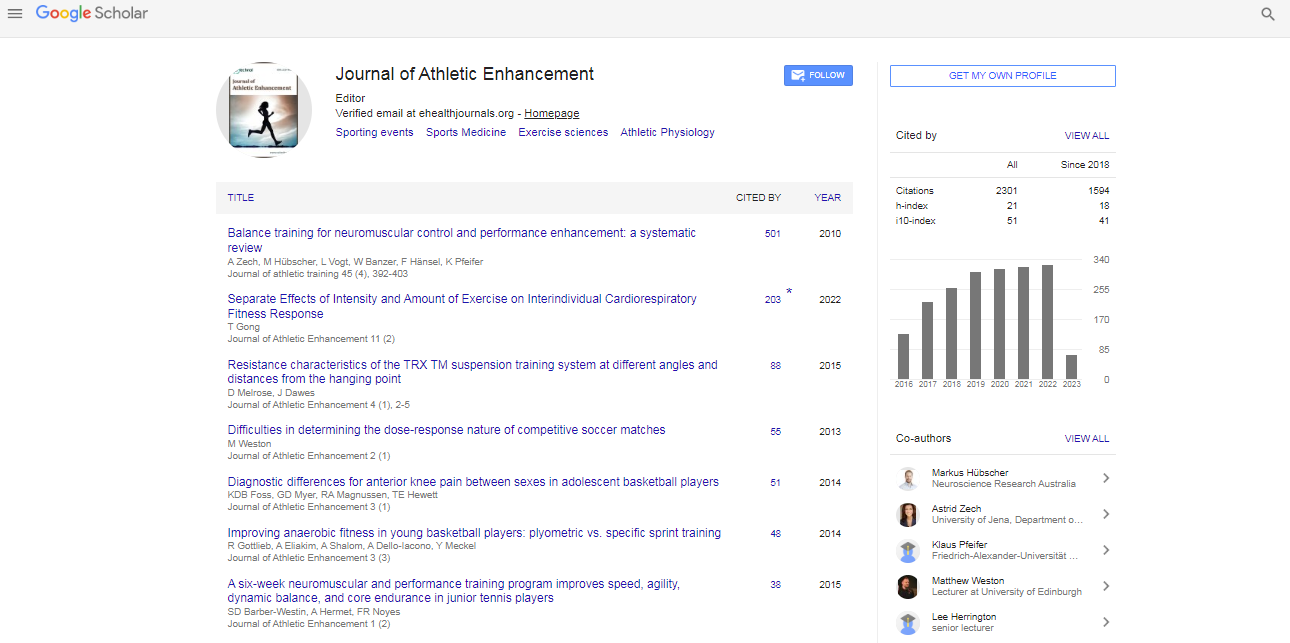Commentary, J Athl Enhanc Vol: 12 Issue: 6
Importance of Physiotherapy in Sports Injury Rehabilitation: Its Techniques and Modalities
Zhang Liu*
1Department of Exercise, Wuhan Business University, Wuhan, China
*Corresponding Author: Zhang Liu,
Department of Exercise, Wuhan Business
University, Wuhan, China
E-mail: 25387liu_zhang@qq.com
Received date: 30 October, 2023, Manuscript No. JAE-24-124071;
Editor assigned date: 02 November, 2023, PreQC No. JAE-24-124071 (PQ);
Reviewed date: 16 November, 2023, QC No. JAE-24-124071;
Revised date: 23 November, 2023, Manuscript No. JAE-24-124071 (R);
Published date: 30 November, 2023 DOI: 10.4172/2324-9080.100086
Citation: Liu Z (2023) Importance of Physiotherapy in Sports Injury Rehabilitation: Its Techniques and Modalities. J Athl Enhanc 12:6.
Description
Physiotherapy, also known as physical therapy, is a healthcare profession focused on improving a person's movement, function, and overall well-being. It encompasses a wide range of techniques and approaches aimed at restoring and maintaining physical functionality, alleviating pain, and enhancing the quality of life for individuals across various age groups and conditions. From injury rehabilitation to chronic pain management and preventive care, physiotherapy plays a pivotal role in enhancing mobility, strength, and independence.
At its core, physiotherapy is guided by several fundamental principles, including assessment, diagnosis, treatment, and prevention of movement dysfunctions. The scope of physiotherapy is extensive, addressing issues stemming from musculoskeletal, neurological, cardiovascular, and respiratory conditions. A physiotherapist, through a comprehensive evaluation, develops tailored treatment plans to cater to individual needs.
The benefits of physiotherapy span across a spectrum of conditions and scenarios. For individuals recovering from injuries or surgeries, physiotherapy aids in restoring strength, flexibility, and range of motion. It also helps manage pain and prevents the onset of secondary complications.
In chronic conditions like arthritis or neurological disorders such as Parkinson's disease, physiotherapy is instrumental in managing symptoms, improving mobility, and enhancing overall quality of life. Additionally, it plays a vital role in sports medicine, assisting athletes in injury prevention, rehabilitation, and performance enhancement.
Techniques and modalities
Physiotherapy employs a variety of techniques and modalities tailored to the specific needs of the patient. These may include:
Manual therapy: Hands-on techniques like massage, joint mobilization, and manipulation to restore movement and reduce pain.
Therapeutic exercises: Customized exercise programs focusing on strength, flexibility, balance, and endurance.
Electrotherapy: The use of electrical stimulation, ultrasound, or heat/cold therapy to alleviate pain and promote healing.
Aquatic therapy: Exercise and rehabilitation performed in a pool to reduce stress on joints and facilitate movement.
Respiratory therapy: Techniques to improve lung capacity and breathing in patients with respiratory conditions.
Neurological rehabilitation: Specialized exercises and activities to help individuals recover from stroke, spinal cord injuries, or other neurological conditions.
Applications in different settings
Physiotherapy finds applications in various healthcare settings:
Hospitals: Post-surgery recovery, critical care, and rehabilitation after injuries.
Private clinics: Personalized treatment plans for individuals with chronic conditions or sports injuries.
Sports teams: Injury prevention, rehabilitation, and performance enhancement for athletes.
Elderly care facilities: Fall prevention programs, mobility enhancement, and pain management for seniors.
Workplace health: Ergonomic assessments, injury prevention strategies, and rehabilitation for work-related injuries.
Physiotherapy adopts a holistic approach, considering not only the physical symptoms but also the psychological and social aspects of an individual’s health. Patient education is a crucial component, empowering individuals to understand their conditions better, adhere to treatment plans, and adopt healthier lifestyle choices to manage their conditions effectively.
Despite its numerous benefits, challenges exist in the field of physiotherapy, including access to services, resource limitations, and evolving technologies. However, advancements in tele-health and wearable technologies offer new avenues for remote monitoring and delivering care to individuals in distant locations.
The future of physiotherapy is promising, with ongoing research in areas such as regenerative medicine, virtual reality-based rehabilitation, and personalized treatment approaches. These developments hold the potential to further enhance the effectiveness and accessibility of physiotherapy services.
Physiotherapy stands as a vital component of healthcare, offering diverse interventions to improve mobility, manage pain, and enhance overall well-being across various populations. Its holistic approach, combined with evolving techniques and technologies, continues to shape the landscape of rehabilitation and preventive care, positively impacting countless lives.
 Spanish
Spanish  Chinese
Chinese  Russian
Russian  German
German  French
French  Japanese
Japanese  Portuguese
Portuguese  Hindi
Hindi 
